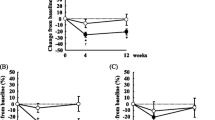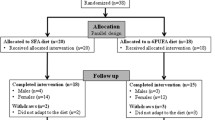Abstract
A large number of papers have reported that administration of n−3 FA reduced serum TG concentrations in hypertriglyceridemic patients. However, few studies have examined the effect of n−3 FA on serum concentrations of remnant-like particle (RLP) cholesterol. Volunteers (n=41) whose serum TG concentrations were 100–300 mg/dL were recruited and randomly assigned to either an n−3 FA group or a control group with stratification by sex, age, and serum TG level in a double-blind manner. The subjects in the n−3 FA group were administered 125 ml of fermented soybean milk with fish oil containing 600 mg of EPA and 260 mg of DHA/d for 12 wk. The controls consumed control soybean milk with olive oil. Fasting blood samples were obtained before the start of administration and at 4, 8 and 12 wk. EPA concentrations in red blood cells increased significantly in all but one subject in the n−3 FA group, with no significant changes in the control group. TG levels decreased more in the n−3 FA group than in the control group at weeks 4 (P<0.05), 8 (P<0.01), and 12 (P<0.05) with their baseline as covariate. RLP cholesterol levels decreased more in the n−3 FA group than in the control at weeks 8 (P<0.01) and 12 (P<0.05) with their baseline as covariate. The groups did not differ in the other lipid levels. It is likely that n−3 long-chain FA may exert anti-atherosclerotic effects by lowering serum TG and RLP-cholesterol levels even at the dose of 860 mg/d.
Similar content being viewed by others
Abbreviations
- apo:
-
apolipoprotein
- LC-PUFA:
-
long-chain PUFA
- RBC:
-
red blood cells
- RLP:
-
remnant-like particle
- SRL:
-
Special Reference Laboratories
References
Smith, S.C., Jr., Blair, S.N., Bonow, R.O., Brass, L.M., Cerqueira, M.D., Dracup, K., Fuster, V., Gotto, A., Grundy, S.M., Miller, N.H., et al. (2001) AHA/ACC Scientific Statement: AHA/ACC Guidelines for Preventing Heart Attack and Death in Patients with Atherosclerotic Cardiovascular Disease: 2001 Update: A Statement for Healthcare Professionals from the American Heart Association and the American College of Cardiology, Circulation 104, 1577–1579.
Burr, M.L., Fehily, A.M., Gilbert, J.F., Rogers, S., Holliday, R.M., Sweetnam, P.M., Elwood, P.C., and Deadman, N.M. (1989) Effects of Changes in Fat, Fish, and Fibre Intakes on Death and Myocardial Reinfarction: Diet and Reinfarction Trial (DART), Lancet 2, 757–761.
Singh, R.B., Niaz, M.A., Sharma, J.P., Kumar, R., Rastogi, V., and Moshiri, M. (1997) Randomized, Double-Blind, Placebo-Controlled Trial of Fish Oil and Mustard Oil in Patients with Suspected Acute Myocardial Infarction: The Indian Experiment of Infarct Survival—4, Cardiovasc. Drugs Ther. 11, 485–491.
GISSI-Prevenzione Intervention (1999) Dietary Supplementation with n−3 Polyunsaturated Fatty Acids and Vitamin E After Myocardial Infarction: Results of the GISSI-Prevenzione Trial, Gruppo Italiano per lo Studio della Sopravvivenza nell'Infarto Miocardico, Lancet 354, 447–455.
Bucher, H.C., Hengstler, P., Schindler, C., and Meier, G. (2002) n−3 Polyunsaturated Fatty Acids in Coronary Heart Disease: A Meta-Analysis of Randomized Controlled Trials, Am. J. Med. 112, 298–304.
Albert, C.M., Campos, H., Stampfer, M.J., Ridker, P.M., Manson, J.E., Willett, W.C., and Ma, J. (2002) Blood Levels of Long-Chain n−3 Fatty Acids and the Risk of Sudden Death, N. Engl. J. Med. 346, 1113–1118.
Kang, J.X., and Leaf, A. (2000) Prevention of Fatal Cardiac Arrhythmias by Polyunsaturated Fatty Acids, Am. J. Clin. Nutr. 71, 202S-207S.
Nakamura, N., Hamazaki, T., Kobayashi, M., Ohta, M., and Okuda, K. (1998) Effects of Eicosapentaenoic Acids on Remnant-Like Particles, Cholesterol Concentrations and Plasma Fatty Acid Composition in Patients with Diabetes Mellitus, In Vivo 12, 311–314.
Nakamura, N., Hamazaki, T., Ohta, M., Okuda, K., Urakaze, M., Sawazaki, S., Yamazaki, K., Satoh, A., Temaru, R., Ishikura, Y., et al. (1999) Joint Effects of HMG-CoA Reductase Inhibitors and Eicosapentaenoic Acids on Serum Lipid Profile and Plasma Fatty Acid Concentations in Patients with Hyperlipidemia, Int. J. Clin. Lab. Res. 29, 22–25.
Takeichi, S., Nakajima, Y., Osawa, M., Yukawa, N., Saito, T., Seto, Y., Nakano, T., Adachi, M., Jitsukata, K., Horiuchi, K., et al. (1997) The Possible Role of Remnant-Like Particles as a Risk Factor for Sudden Cardiac Death, Int. J. Leg. Med. 110, 213–219.
Glanville, J.N. (1960) Post-mortem Serum Cholesterol Levels, Br. Med. J. 2, 1852–1853.
Hornick, C.A., Backer, H.N., Malcom, G.T., Newman, W.P., Roheim, P.S., and Strong, J.P. (1988) Lipoproteins and Apolipoproteins in Post-mortem Serum, Mod. Pathol. 1, 480–484.
Hamazaki, T., Sawazaki, S., Itomura, M., Asaoka, E., Nagao, Y., Nishimura, N., Yazawa, K., Kuwamori, T., and Kobayashi, M. (1996) The Effect of Docosahexaenoic Acid on Aggression in Young Adults. A Placebo-Controlled Double-Blind Study, J. Clin. Invest. 97, 1129–1133.
Kobayashi, S., Hamazaki, T., Sawazaki, S., and Nakamura, H. (1992) Reduction in the ADP Release from Shear-Stressed Red Blood Cells by Fish Oil Administration, Thromb. Res. 65, 353–364.
Folch, J., Lees, M., and Sloane-Stanley, G.H. (1957) A Simple Method for the Isolation and Purification of Total Lipids from Animal Tissues, J. Biol. Chem. 226, 497–509.
Tamaoku, K., Ueno, K., Akiura, K., and Ohkuma, Y. (1982) New Water-Soluble Hydrogen Donors for the Enzymatic Photometric Detemrination of Hydrogen Peroxide. II. N-Ethyl-N-(2-hydroxy-3-sulfopropyl) Aniline Derivatives, Chem. Pharm. Bull. 30, 2492–2497.
Richmond, W. (1973) Preparation and Properties of a Cholesterol Oxidase from Nocardia sp. and Its Application to the Enzymatic Assay of Total Cholesterol in Serum, Clin. Chem. 19, 1350–1356.
Nakajima, K., Saito, T., Tamura, A., Suzuki, M., Nakano, T., Adachi, M., Tanaka, A., Tada, N., Nakamura, H., Campos, E., et al. (1993) Cholesterol in Remnant-Like Lipoproteins in Human Serum Using Monoclonal Anti ApoB-100 and Anti ApoA-I Immunoaffinity Mixed Gels, Clin. Chim. Acta 223, 53–71.
Nakajima, K., Okazaki, M., Tanaka, A., Pullinger, C.R., Wang, T., Nakano, T., Adachi, M., and Havel, R.J. (1996) Separation and Determination of Remnant-Like Particles in Human Serum Using Monoclonal Antibodies to ApoB-100 and ApoA-1, J. Clin. Lignand Assay 19, 177–183.
Tsuji, E., and Tsuji, K. (1998) Japanese Dietary Fatty Acid Intake, J. Lipid Nutr. 7, 56–65.
Harris, W.S. (1997) n−3 Fatty Acids and Serum Lipoproteins: Human Studies, Am. J. Clin. Nutr. 65, 1645S-1654S.
Higgins, S., Carroll, Y.L., McCarthy, S.N., Corridan, B.M., Roche, H.M., Wallace, J.M., O'Brien, N.M., and Morrissey, P.A. (2001) Susceptibility of LDL to Oxidative Modification in Healthy Volunteers Supplemented with Low Doses of n−3 Polyunsaturated Fatty Acids, Br. J. Nutr. 85, 23–31.
Takanami, Y., and Shimomitsu, T. (1999) Mild Exercise Training Is an Effective Therapy to Reduce the Serum Remnant-Like Particles in Subjects with High Remnants Despite the Lack of Weight of Body Fat Loss, Circulation 100 (Suppl.), I-822.
Jialal, I., and Devaraj, S. (2002) Remnant Lipoproteins: Measurement and Clinical Significance, Clin. Chem. 48, 217–219.
Karpe, F., Boquist, S., Tang, R., Bond, G.M., de Faire, U., and Hamsten, A. (2001) Reinnant Lipoproteins Are Related to Intime-Media Thickness of the Carotid Artery Independently of LDL Cholesterol and Plasma Triglycerides, J. Lipid Res. 42, 17–21.
Kugiyama, K., Doi, H., Takazoe, K., Kawano, H., Soejima, H., Mizuno, Y., Tsunoda, R., Sakamoto, T., Nakano, T., Nakajima, K., et al. (1999) Remnant Lipoprotein Levels in Fasting Serum Predict Coronary Events in Patients with Coronary Artery Disease, Circulation 99, 2858–2860.
McNamara, J.R., Shah, P.K., Nakajima, K., Cupples, L.A., Wilson, P.W., Ordovas, J.M., and Schaefer, E.J. (2001) Remnant-Like Particle (RLP) Cholesterol Is an Independent Cardiovascular Disease Risk Factor in Women: Results from the Framingham Heart Study, Atherosclerosis 154, 229–236.
Saniabadi, A.R., Umemura, K., Shimoyama, M., Adachi, M., Nakano, M., and Nakashima, M. (1997) Aggregation of Human Blood Platelets by Remnant-Like Lipoprotein Particles of Plasma Chylomicrons and Very Low Density Lipoproteins, Thromb. Haemost. 77, 996–1001.
Knöfler, R., Nakano, T., Nakajima, K., Takada, Y., and Takada, A. (1995) Remnant-Like Lipoproteins Stimulate Whole Bood Platelet Aggregation in vitro, Thromb. Res. 78, 161–171.
Tomono, S., Kawazu, S., Kato, N., Ono, T., Ishii, C., Ito, Y., Shimizu, M., Shimoyama, M., Nakano, T., and Nakajima, K. (1994) Uptake of Remnant-Like Particles (RLP) in Diabetic Patients from Mouse Peritoneal Macrophages, J. Atheroscler. Thromb. 1, 98–102.
Zheng, X., Avella, M., and Botham, K.M. (2001) Comparison of the Effects of Dietary n−3 and n−6 Polyunsaturated Fatty Acids on Very-Low-Density Lipoprotein Secretion When Delivered to Hepatocytes in Chylomicron Remnants, Biochem. J. 357, 481–487.
Author information
Authors and Affiliations
Corresponding author
About this article
Cite this article
Hamazaki, K., Itomura, M., Huan, M. et al. n−3 long-chain FA decrease serum levels of TG and remnant-like particle-cholesterol in humans. Lipids 38, 353–358 (2003). https://doi.org/10.1007/s11745-003-1069-x
Received:
Accepted:
Issue Date:
DOI: https://doi.org/10.1007/s11745-003-1069-x




